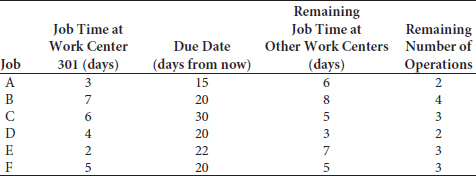COMPARING PRIORITY RULES
Now that you know how to use priority rules and how to measure schedule effectiveness, compare the effectiveness of different priority rules.
EXAMPLE 15.6 Using SPT
Using the job information shown in Table 15-2, compare the shortest processing time priority rule (SPT) to the slack per remaining operations priority rule (S/RO). Determine the job sequence and calculate mean job flow time, average number of jobs in the system, mean job lateness, and mean job tardiness.
• Before You Begin: First, develop the sequence of jobs using the appropriate priority rule. Begin with SPT and calculate the performance measurements. Repeat using S/RO.
Table 15-2 Job Data

The first priority rule is SPT and the available jobs are listed, so we need to calculate only the sequence. Using SPT, we base the sequence on doing the job that needs the least amount of time at the work center first (in our case, job E). We do job E first, and then we look for the next shortest job time (job A takes three days) to be second in our sequence. The complete sequence for SPT is job E, A, D, F, C, and then B, shown graphically here.
![]()
Using this information, we calculate the mean job flow time. The flow time for job E is 2 days; for job A it is 5 days; for job D it is 9 days; for job F it is 14 ...
Get Operations Management: An Integrated Approach, 5th Edition now with the O’Reilly learning platform.
O’Reilly members experience books, live events, courses curated by job role, and more from O’Reilly and nearly 200 top publishers.

